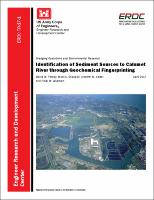Please use this identifier to cite or link to this item:
https://hdl.handle.net/11681/22191| Title: | Identification of sediment sources to Calumet River through geochemical fingerprinting |
| Authors: | Perkey, David W. Chappell, Mark A. (Mark Allen) Seiter-Moser, Jennifer M. Wadman, Heidi M. |
| Keywords: | Calumet River (Ill.) Contaminated sediment Dredging Dredging spoil Contaminated sediments Geochemical fingerprint Environmental geochemistry Lake Calumet Principal component analysis Sedimentation and deposition Sedimentation and analysis Sediment source |
| Publisher: | Coastal and Hydraulics Laboratory (U.S.) Environmental Laboratory (U.S.) Engineer Research and Development Center (U.S.) |
| Series/Report no.: | ERDC;TR-17-1 |
| Abstract: | Abstract: Geochemical sedimentary markers provide a well-established methodology for fingerprinting various sources of sediments accumulating within a region of concern. To help identify possible sources of contaminated sediment infilling a reach of the Calumet River between the Thomas J. O’Brien lock and Lake Michigan, multiple bottom sediment samples were collected in 2014 from six potential sediment sources. Additionally, geochemical data from historic dredging records spanning a 40-year period were examined to develop a historic geochemical fingerprint for sediments within this reach of the river. Geochemical measurements and advanced multivariate statistics were used to successfully distinguish between all six potential sediment sources. Calumet River samples showed elevated levels of heavy metals and a geochemical signature that was distinct from the potential source sediments, suggesting that heavy metal contamination was occurring locally within the river. Additionally, multivariate analysis was able to show historic reductions in heavy metal and organic contaminants in the dredge records that likely correlates with implementation of the Clean Water Act. Geochemical fingerprints were successfully used to track changes in sediments both spatially and temporally within the project area. These fingerprints could be used further to identify any future changes in sediments within this reach of the Calumet River. |
| URI: | http://hdl.handle.net/11681/22191 http://dx.doi.org/10.21079/11681/22191 |
| Appears in Collections: | Technical Report |
Files in This Item:
| File | Description | Size | Format | |
|---|---|---|---|---|
| ERDC TR-17-1.pdf | 5.81 MB | Adobe PDF |  View/Open |